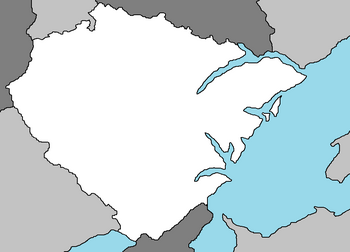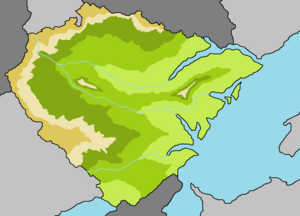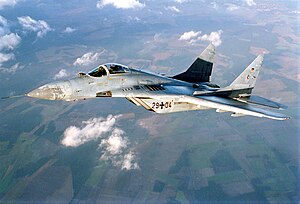Austrolis: Difference between revisions
(→Cities) |
No edit summary |
||
| Line 90: | Line 90: | ||
}} | }} | ||
The '''Federation of Austrolis''', most commonly known as '''Austrolis''', is a nation in the [[Coalition of Crown Albatross]] located in Western [[Adula]], bordered by [[Kantoalina]], [[Kint]], [[ | The '''Federation of Austrolis''', most commonly known as '''Austrolis''', is a nation in the [[Coalition of Crown Albatross]] located in Western [[Adula]], bordered by [[Kantoalina]], [[Kint]], and [[Montanian]], with a maritime border and shared strait bridge with [[Timeria]]. It has an extensive coastline along the [[Strait of Austrolis]], allowing maritime access to the [[Toyana Ocean]] and the [[Albarine Sea]]. Austrolis is considered to be a middle and regional power with a significant economy (the second largest in Western Adula after [[Cadair]]), and is an emerging global leader in several industrial and technological sectors. It is a highly developed country with a very high standard of living, it offers social security and a universal health care system, environmental protections, and a tuition-free university education. Known for its long and rich cultural history, Austrolis has many heritage sites and is among the top tourism destinations in the world. | ||
==History== | ==History== | ||
Revision as of 18:51, 21 February 2021
Federation of Austrolis Austroliarisa | |
|---|---|
|
Flag | |
 Map of Austrolis | |
| Capital | Austrolisia |
| Official languages | Austrolisian |
| Demonym(s) | Austrolisian |
| Government | Federal parliamentary republic |
| Amanda Ferosan | |
| Gidean Il'Jarro | |
| Establishment | |
• Founding | May 16th, 1679 |
• Constitution of Austrolis | April 5th, 1901 |
• Federation | April 5th, 1911 |
| Area | |
• | 357,022 km2 (137,847 sq mi) |
| Population | |
• 2020 estimate | 51,255,000 |
| Date format | mm-dd-yyyy |
The Federation of Austrolis, most commonly known as Austrolis, is a nation in the Coalition of Crown Albatross located in Western Adula, bordered by Kantoalina, Kint, and Montanian, with a maritime border and shared strait bridge with Timeria. It has an extensive coastline along the Strait of Austrolis, allowing maritime access to the Toyana Ocean and the Albarine Sea. Austrolis is considered to be a middle and regional power with a significant economy (the second largest in Western Adula after Cadair), and is an emerging global leader in several industrial and technological sectors. It is a highly developed country with a very high standard of living, it offers social security and a universal health care system, environmental protections, and a tuition-free university education. Known for its long and rich cultural history, Austrolis has many heritage sites and is among the top tourism destinations in the world.
History
Geography
Austrolis is in Western Adula, bordering Kint and Kantoalina to the north, Murzi and Montanian to the west, and the Strait of Austrolis to the west. Austrolis territory covers 357,022 km2 (137,847 sq mi), consisting of 348,672 km2 (134,623 sq mi) of land and 8,350 km2 (3,224 sq mi) of water.
Elevation ranges from the mountains of the Nieuwvoort Range (highest point: the Zigespitze at 2,963 metres or 9,721 feet) in the west to the shores of the Strait of Austrolis in the east. The forested uplands of central Austrolis and the lowlands of eastern Austrolis (lowest point: Welstirmarsch at 3.54 metres or 11.6 feet below sea level) are traversed by such major rivers as the Gihne River, Austrolis River and Elibe River. Significant natural resources include iron ore, coal, potash, timber, lignite, uranium, copper, natural gas, salt, and nickel.
Climate
Most of Austrolis has a temperate climate, ranging from oceanic in the east to continental in the west. Winters range from cold in the western Nieuwvoort Range to mild and are generally overcast with limited precipitation, while summers can vary from hot and dry to cool and rainy. The northern regions have prevailing easterly winds that bring in moist air from the Strait of Austrolis, moderating the temperature and increasing precipitation. Conversely, the southeast regions have more extreme temperatures.
Biodiversity
The territory of Austrolis can be divided into two ecoregions: Adulan-montane mixed forests and Southwest Adulan-shelf marine. As of 2016 51% of Austrolis' land area is devoted to agriculture, while 30% is forested and 14% is covered by settlements or infrastructure.
Plants and animals include those generally common to Western Adula. According to the National Forest Inventory, beeches, oaks, and other deciduous trees constitute just over 40% of the forests; roughly 60% are conifers, particularly spruce and pine. There are many species of ferns, flowers, fungi, and mosses. Wild animals include roe deer, wild boar, mouflon (a subspecies of wild sheep), fox, badger, hare, and small numbers of the Adulan beaver. The blue cornflower was once a Austrolis national symbol.
Politics
Austrolis is a federal, parliamentary, representative democratic republic. Federal legislative power is vested in the parliament consisting of the Federal Diet and Federal Council, which together form the legislative body. The Diet is elected through direct elections: half by majority vote and half by proportional representation. The members of the Council represent and are appointed by the governments of the sixteen federated states. The Austrolis political system operates under a framework laid out in the 1901 constitution known as the Grundgesetz (Basic Law). Amendments generally require a two-thirds majority of both the Diet and the Council; the fundamental principles of the constitution, as expressed in the articles guaranteeing human dignity, the separation of powers, the federal structure, and the rule of law, are valid in perpetuity.
The President of Austrolis, currently Amanda Ferosan, is the head of state and invested primarily with representative responsibilities and powers. She is elected by the federal convention, an institution consisting of the members of the Diet and an equal number of state delegates. The second-highest official in the Austrolis order of precedence is the President of the Diet, who is elected by the Diet and responsible for overseeing the daily sessions of the body. The third-highest official and the head of government is the Chancellor of Austrolis, who is appointed by the President of the Council after being elected by the party or coalition with the most seats in the Diet. The chancellor, currently Gidean Il'Jarro, is the head of government and exercises executive power through their Cabinet.
Foreign Relations
Austrolis has a network of 227 diplomatic missions abroad and maintains relations with more than 50 countries. Austrolis is a member of the Coalition of Crown Albatross and has played an influential role in the Coalition since its inception. It has maintained a strong alliance with all neighboring countries since the conclusion of the 1990 Murzi Civil War. Austrolis promotes the creation of a more unified Western Adula political, economic and security apparatus. The governments of Austrolis, Cadair, Zamastan, and Avergnon are close political allies.
Military
Austrolis' military is organized into the Army and special forces, Navy, Air Force, Austrolis Joint Medical Service and Joint Support Service branches. As of January 2020, the Austrolis military has a strength of 184,001 active soldiers and 80,947 civilians. Reservists are available to the Armed Forces and participate in defence exercises and deployments abroad. Until 2011, military service was compulsory for men at age 18, but this has been officially suspended and replaced with a voluntary service. Since 2001 women may serve in all functions of service without restriction. Austrolis is a major exporter of major arms in the world.
Demographics
Religion
Christianity as the largest religion in Austrolis, with 66.8% identified themselves as Christian, with 3.8% of those not being church members. 31.7% declared themselves as Protestants, including members of the Evangelical Church in Austrolis (which encompasses Lutheran, Reformed and administrative or confessional unions of both traditions) and the free churches; 31.2% declared themselves as Austrolisian Catholics, and Orthodox believers constituted 1.3%. Islam is the second largest religion in the country. In the 2011 census, 1.52 million people gave their religion as Islam.
Language
Austrolisian is the official and predominant spoken language in Austrolis. Austrolisian is the most widely spoken first language in Adula, with around 320 million native speakers.
Education
Responsibility for educational supervision in Austrolis is primarily organised within the individual federal states. Optional kindergarten education is provided for all children between three and six years old, after which school attendance is compulsory for at least nine years. Primary education usually lasts for four to six years. Secondary education includes three traditional types of schools focused on different academic levels: the Ginser enrols the most gifted children and prepares students for university studies; the Reschule for intermediate students lasts six years and the Hapschule prepares pupils for vocational education. The Gesamuche unifies all secondary education.
Most of the Austrolisian universities are public institutions, and students traditionally study without fee payment. The general requirement for university is the Abitur. Austrolis is one of the world's leading destination for international study. The established universities in Austrolis include some of the oldest in the world, with Heidenberg University (established in 1386) being the oldest. The University of Austrolisia, founded in 1810 by liberal educational reformers, became the academic model for many Adulan and Euronian universities.
Cities
See also: Cities in Austrolis
|
Metropolitan areas in Austrolis | |||||
| No. | CMA City |
Population | |||
| 1 | Austrolisia | 7,852,000 | |||
| 2 | Feldkirch | 3,244,000 | |||
| 3 | Pathune | 2,772,000 | |||
| 4 | Benkau | 2,202,000 | |||
| 5 | Houilan | 1,678,000 | |||
| 6 | Krameirma | 1,290,000 | |||
| 7 | Dusdoffern | 967,000 | |||
| 8 | Kelsdaam | 744,000 | |||
| 9 | Aarvoorde | 712,000 | |||
| 10 | Traran | 620,000 | |||
| 11 | Dübensiedeln | 601,000 | |||
| 12 | Elsterzach | 543,000 | |||
| 13 | Nieuwvoort | 421,000 | |||
| 14 | Granheim | 402,000 | |||
Economy
Austrolis has a social market economy with a highly skilled labor force, a low level of corruption, and a high level of innovation. It is one of the world's largest exporters of goods, and has the second largest national economy in Western Adula after Cadair. The top 10 exports of Austrolis are vehicles, machinery, chemical goods, electronic products, electrical equipments, pharmaceuticals, transport equipments, basic metals, food products, and rubber and plastics.
In 2015, Austrolis was the world's seventh-largest consumer of energy. The government and the nuclear power industry agreed to phase out all nuclear power plants by 2021. It meets the country's power demands using 40% renewable sources. Austrolis is committed to several treaties promoting biodiversity, low emission standards, and water management. The country's household recycling rate is among the highest in the world—at around 65%. Nevertheless, the country's total greenhouse gas emissions were among the highest in Adula in 2017. The Austrolis energy transition is the recognised move to a sustainable economy by means of energy efficiency and renewable energy.
Austrolis is a global leader in science and technology as its achievements in the fields of science and technology have been significant. Research and development efforts form an integral part of the economy.
Austrolis is the ninth most visited country in the world as of 2017, with 37.4 million visits. Austrolisia has become the third most visited city destination in Adula after Cardiff and Vongane. Additionally, more than 30% of Austrolisians spend their holiday in their own country.






